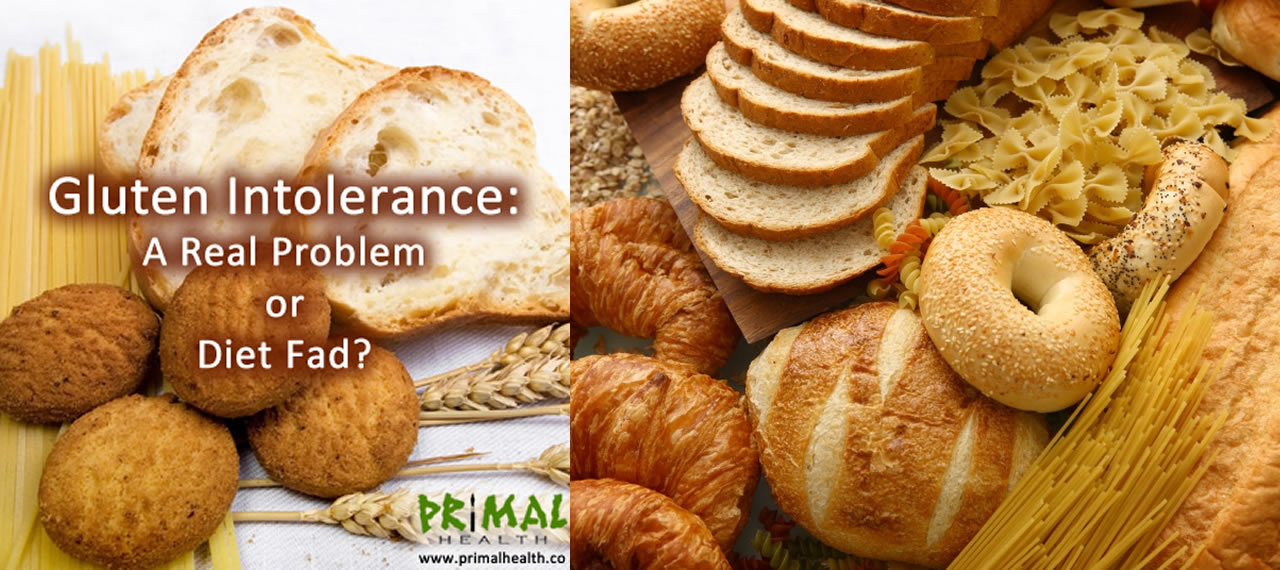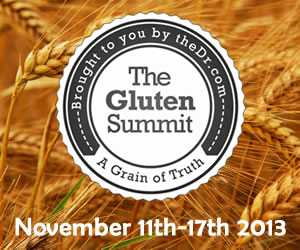Are you getting sick of hearing about gluten yet? Or are you getting sick from eating it? With the gluten-free craze reaching new heights every day, it’s sometimes hard to tell what is breakthrough science and miraculous cures, and what is marketing hype and diet fashion. So here’s what’s really going on with the gluten thing…
What exactly is Gluten Intolerance?
Gluten is a protein found in wheat and related grains. Gluten intolerance is not an allergy – it’s a physical condition in the small intestine that goes like this:
1/ You can’t digest the gluten properly, so it hangs out in your small intestines.
2/ Your body sees this gluten ‘hanging out’ as a foreign invader, which it doesn’t like.
3/ Your small intestine gets irritated/inflamed. This flattens the microvilli along the intestinal wall.
4/ Without your microvilli active, you have less area to absorb nutrients from your food. You suffer from malabsorption.
5/ The malabsorption leads to nutrient deficiency, which leads to symptoms of disease.
So you can see how if you don’t realise you are gluten intolerant for the first 20-40 years of your life, that is a long time for gluten to continue damaging your guts and your immune system.
What starts out as intestinal damage leads to malabsorption, which leads to vitamin and mineral deficiencies, which leads to autoimmune disease, liver damage, hormone disruption, and more.
What are the symptoms of gluten intolerance?
As proper digestion and nutrient intake are required for all of our bodily processes, the damage from gluten intolerance can show up in your body in a multitude of various ills, pains and diseases. Therefore, any of these symptoms could be a sign that you have gluten intolerance.
– Fatigue after eating gluten / Chronic fatigue
– Headaches & Migraines
– Skin rashes & disorders
– Depression, mood swings, anxiety, mental fogginess, ADD
– Weight gain or weight loss
– Digestive issues like bloating, gas, cramping, diarrhea, constipation, IBS
– Autoimmune disease diagnosis such as Hashimoto’s thyroiditis, Rheumatoid arthritis, Ulcerative colitis, Lupus, Psoriasis, Scleroderma or Multiple sclerosis
– PMS, PCOS, unexplained infertility
– Swelling or pain in joints / fibromyalgia / tingling or numbness in extremities
Of course, these symptoms could also have other causes and not be linked to gluten intolerance. So be careful not to jump to conclusions solely based on the presence of related symptoms.
Symptoms alone are not evidence of gluten intolerance. However, if you completely remove gluten from your diet for awhile and symptoms improve, then you know you are onto something!
Are there tests for gluten intolerance?
You have some symptoms, so how do you confirm if it’s gluten intolerance? There are a few problems with traditional gluten intolerance testing. The first is that even if you are gluten intolerant, the test may come back negative if you have already started to cut gluten out of your diet. Secondly, the most common blood tests only test for one type of protein component in wheat, called gliadin. However, there are a handful of other components in the wheat that your body could be reacting to. So you could come back with tests saying that you should be all good to eat wheat, when really you are not.
What about Celiac Disease?
Celiac Disease is one possible result of gluten intolerance, so it is possible to be gluten intolerant but not have celiac disease. Celiac disease is an autoimmune response to the gluten proteins in your gut.
Again, the testing for this disease is not very reliable, as the test can come back negative if you are not currently eating gluten, or if the test sampled a less damaged section of the gut. Plus, as the disease is only one result of gluten intolerance, you may test negative for celiac but still have a problem with gluten.
There are now other lesser-known tests that have been developed to be more detailed and reliable at detecting an intolerance to gluten, however the best test is still the elimination diet.
Elimination is the best test
Therefore, the absolute best way to determine if you have a gluten intolerance is to completely remove gluten from your diet for at least 30 days, and see if your symptoms subside or go away.
In order to get accurate results here, you must eliminate gluten from your diet 100% . No 80/20 gluten eating! List every single nagging symptom you have, no matter how infrequent. After the elimination period, see how many of your symptoms remain. If most symptoms are gone, you may just want to stay with your new diet – your body likes it! If you are not sure, you can then reintroduce gluten to see if the symptoms reappear.
Just as it can take decades for the effects of gluten damage to manifest into symptoms, it can also take months or years to clear it from your system and heal the gut damage. So the longer you can eliminate it from your diet, the better.
In addition, some gluten-free grains like corn, oats and rice contain proteins that are similar in structure to gluten and therefore still cause an immune response in people with gluten intolerance. This is why a large percentage of people who go gluten-free only feel better for awhile, until they also then do the elimination test with the other grains.
Why is gluten intolerance on the rise?
There are several theories and discussions in the health community about this. Mainly they point to modern agriculture using hybridised grains for high yields. These modern grains are different from the ancient grains that many cultures have safely consumed as a staple for centuries. Additionally, traditional cultures always soaked and prepared their grains thoroughly before consumption, which is not at all the case today.
The Gluten Free Diet-Fad
When going gluten-free, DO NOT get sucked into the marketing madness of gluten-free products! This is when eating a gluten-free diet can be just as, if not more dangerous than just eating the grains. Gluten-free breads, pastas, cereals, flours and snacks are often nutrient deficient, over-processed foods that will also cause digestive distress and nutrient deficiency.
Remember that food corporations are not health professionals! They are simply manufacturers of products who want to cater to what the public wants. If everyone is going gluten-free, they will put that label on anything they can find to sell. Gluten-free Oreo cookies, anyone?
Eating Gluten-Free Package-Free
All fruits, vegetables and animal foods are naturally gluten-free, and so that is what makes up a gluten-free diet. This is a very Primal diet! Just make sure that your animal foods are as unprocessed/packaged as possible, to ensure there has been no added gluten (as in the case with sausages, roast chicken spices, etc.). If you do have packaged foods, beware of gluten going by different ingredient names. Celiac.com has a long list of label ingredients that typically contain hidden gluten.
To get started on how to go gluten-free package free, check out my simple formula for Primal Meals.
THE WORLD’S FIRST GLUTEN SUMMIT!
Here’s a sign that gluten intolerance is definitely on the rise, and your chance to learn more about it from the experts. Dr. Tom O’Bryan of the Dr.com has gathered 29 of the world’s experts and opinion leaders on the topics of gluten-related disorders, nutrition and healthy living for a series of online interviews taking place for FREE from November 11-17, 2013.
If you’re reading this after the date of the summit, you can still click on the image below to access all the speakers talks in a great package for a small price.
- Learn about the latest research on gluten-related disorders
- Understand why we MUST call more attention to them
- Gain improved knowledge of proper diagnosis/treatment methods
References:
http://www.naturalnews.com/038170_gluten_sensitivity_symptoms_intolerance.html
http://chriskresser.com/50-shades-of-gluten-intolerance
http://www.foodrenegade.com/the-rise-of-gluten-intolerance/
What is your experience with gluten symptoms, elimination and gluten-free diets?
Gluten Intolerance: A Real Problem or a Diet Fad? – May 2016









